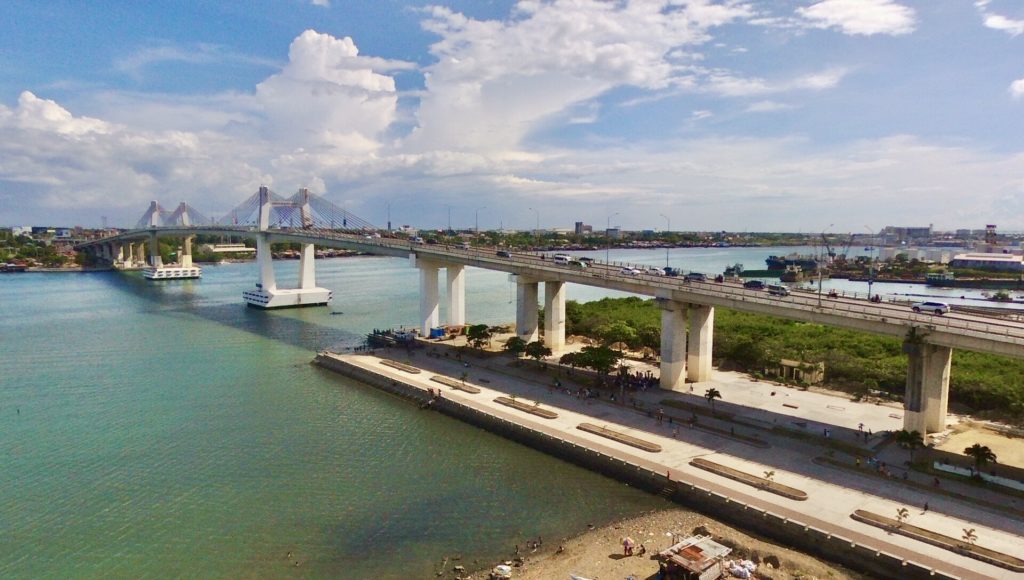Experts: Cebu on its way flattening the curve but…

An aerial shot of the Marcelo Fernan Bridge that connects Mactan Island to mainland Cebu. CDN Digital photo | Brian J. Ochoa
CEBU CITY, Philippines — Experts from the academe have noted a decrease in Cebu island’s coronavirus disease 2019 (COVID-19) transmission rate.
In its 12th coronavirus disease 2019 (COVID-19) forecast report dated July 16, 2020, the OCTA Research team said they observed a downtrend in the number of new COVID-19 cases in Cebu.
It was penned by OCTA Research fellows Guido David, Ranjit Singh Rye, Ma Patricia Agbulos, and Rev. Fr. Nicanor Austriaco.
“In Cebu province (referring to Cebu as an island), the average reproduction number Rt during ECQ has gone down to 1.14 from a high of 2 (based on our last forecast of June 29, 2020),” portions of the document read.
But despite this trend, researchers still classify it as a high-risk area due to the ‘high number of community transmissions’, prompting a recommendation for local officials to continue the island-province’s strict quarantine strategy.
Based on their observations, the team attributed the decline in the number of new COVID-19 cases in Cebu to interventions made by the national and local governments in implementing stricter health protocols.
“In Cebu, the strategy to contain the virus has been working. The stricter quarantine status together with the scaled-up testing, tracing, isolation, and treatment strategies implemented by the national and local governments and supported by the community have significantly decreased the Rt (reproduction number),” the study said.
It also added that Cebu is now making progress in terms of flattening the curve. But to make sure such a trend will be sustained, experts said strict quarantine strategies should be continued.
“Cebu province (including the cities of Cebu, Mandaue, and Lapu-Lapu) has been able to contain the surge and is on the way to flattening the epidemic curve. For Cebu City, we recommend the continuation of the strict quarantine strategy to sustain the gains already achieved,” they said.
The report also warned the government of a premature downgrading of Cebu City’s quarantine status.
“We caution the national government against prematurely downgrading the quarantine status in Cebu City and the NCR… If an ECQ or MECQ status is sustained in Cebu City for another 14 days, then the whole province will be on a trajectory towards flattening its epidemic curve,” it added.
The city, which happens to be the province’s capital, is the lone area in the country that remained under a modified enhanced community quarantine (MECQ). Its neighboring cities and municipalities, however, have since shifted to a more relaxed general community quarantine (GCQ).
It can be recalled that the national government’s anti-coronavirus task force placed Cebu City back under ECQ, the strictest form of community quarantine, last June 16 due to high case doubling time and utilization rates in hospitals reaching critical levels.
Last July 16, it was downgraded to MECQ and is expected to last until July 31.
Projection
In the same study, experts projected that the total number of COVID-19 cases nationwide could go beyond 85,000 by the end of July, with 2,000 deaths.
“Assuming that the reproduction number, Rt remains and there is no significant change in the interventions and strategies by the government, based on our revised projections, the current number of cases in the Philippines will increase to more than 85,000 and 2,000 deaths by end of July 2020,” said the report.
Data from the Department of Health (DOH) showed that the country has recorded a total of 67,456 COVID-19 cases as of July 19. Of this number, 1,831 were classified as mortalities while 22, 465 others as recoveries.
Researchers also raised concern on the increase in Metro Manila’s COVID-19 transmission rate.
Among the recommendations they provided to the government in addressing this matter was to have the National Capital Region (NCR) be placed back under stricter quarantine settings, similar to what happened in Cebu City.
“We believe that this option will work in the NCR as well,” they said.
In Cebu, most parts of the province have been downgraded to a modified GCQ (MGCQ).
The areas that remain under GCQ are the cities of Mandaue, Lapu-Lapu, Talisay, and the towns of Consolacion and Minglanilla, all of which recorded a high number of COVID-19 cases, and in close proximity with Cebu City.
Data from the DOH in Central Visayas (DOH – 7) showed that Cebu, as an island, has already documented over 13,000 coronavirus cases with close to 400 deaths, and around 6,000 recoveries. /dbs
Disclaimer: The comments uploaded on this site do not necessarily represent or reflect the views of management and owner of Cebudailynews. We reserve the right to exclude comments that we deem to be inconsistent with our editorial standards.
